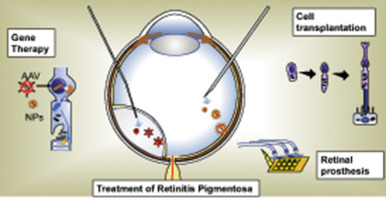Progress in Retinal and Eye Research ( IF 18.6 ) Pub Date : 2017-10-31 , DOI: 10.1016/j.preteyeres.2017.10.004 Marina França Dias , Kwangsic Joo , Jessica A. Kemp , Silvia Ligório Fialho , Armando da Silva Cunha , Se Joon Woo , Young Jik Kwon

|
Retinitis Pigmentosa (RP) is a hereditary retinopathy that affects about 2.5 million people worldwide. It is characterized with progressive loss of rods and cones and causes severe visual dysfunction and eventual blindness in bilateral eyes. In addition to more than 3000 genetic mutations from about 70 genes, a wide genetic overlap with other types of retinal dystrophies has been reported with RP. This diversity of genetic pathophysiology makes treatment extremely challenging. Although therapeutic attempts have been made using various pharmacologic agents (neurotrophic factors, antioxidants, and anti-apoptotic agents), most are not targeted to the fundamental cause of RP, and their clinical efficacy has not been clearly proven. Current therapies for RP in ongoing or completed clinical trials include gene therapy, cell therapy, and retinal prostheses. Gene therapy, a strategy to correct the genetic defects using viral or non-viral vectors, has the potential to achieve definitive treatment by replacing or silencing a causative gene. Among many clinical trials of gene therapy for hereditary retinal diseases, a phase 3 clinical trial of voretigene neparvovec (AAV2-hRPE65v2, Luxturna) recently showed significant efficacy for RPE65-mediated inherited retinal dystrophy including Leber congenital amaurosis and RP. It is about to be approved as the first ocular gene therapy biologic product. Despite current limitations such as limited target genes and indicated patients, modest efficacy, and the invasive administration method, development in gene editing technology and novel gene delivery carriers make gene therapy a promising therapeutic modality for RP and other hereditary retinal dystrophies in the future.
中文翻译:

色素性视网膜炎的分子遗传学和新兴疗法:基础研究和临床观点
色素性视网膜炎(RP)是一种遗传性视网膜病,全世界约有250万人受其影响。其特征是视杆和视锥进行性丧失,并导致严重的视力障碍和最终导致双眼失明。除了来自约70个基因的3000多个遗传突变外,RP还报道了与其他类型的视网膜营养不良的广泛遗传重叠。遗传病理生理学的这种多样性使治疗极具挑战性。尽管已经尝试使用各种药物(神经营养因子,抗氧化剂和抗细胞凋亡剂)进行治疗,但大多数药物并未针对RP的根本原因,并且尚未明确证明其临床疗效。正在进行或已完成的临床试验中,目前有关RP的疗法包括基因疗法,细胞疗法,和视网膜假体。基因疗法是一种使用病毒或非病毒载体纠正遗传缺陷的策略,它有可能通过取代或沉默致病基因来实现确定的治疗。在遗传性视网膜疾病的基因治疗的许多临床试验中,Voretigene neparvovec(AAV2-hRPE65v2,Luxturna)的3期临床试验最近显示出对RPE65介导的遗传性视网膜营养不良的有效疗效,包括Leber先天性黑ama病和RP。它即将被批准为第一个眼基因治疗生物制品。尽管目前存在一些局限性,例如靶基因和所针对的患者有限,疗效不佳以及侵入性给药方法,











































 京公网安备 11010802027423号
京公网安备 11010802027423号